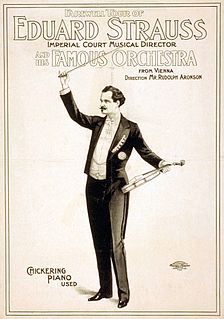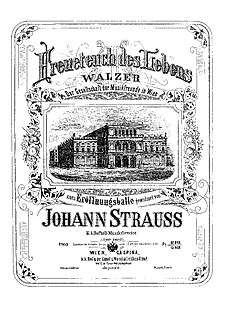Related Research Articles
The polka is originally a Czech dance and genre of dance music familiar throughout all of Europe and the Americas. It originated in the middle of the nineteenth century in Bohemia, now part of the Czech Republic. The polka remains a popular folk music genre in many European and American countries, and is performed by many folk artists.

Johann Strauss II, also known as Johann Strauss Jr., the Younger, the Son, was an Austrian composer of light music, particularly dance music and operettas. He composed over 500 waltzes, polkas, quadrilles, and other types of dance music, as well as several operettas and a ballet. In his lifetime, he was known as "The Waltz King", and was largely responsible for the popularity of the waltz in Vienna during the 19th century. Some of Johann Strauss's most famous works include "The Blue Danube", "Kaiser-Walzer", "Tales from the Vienna Woods", and the "Tritsch-Tratsch-Polka". Among his operettas, Die Fledermaus and Der Zigeunerbaron are the best known.

Johann Strauss I was an Austrian Romantic composer. He was famous for his waltzes, and he popularized them alongside Joseph Lanner, thereby setting the foundations for his sons to carry on his musical dynasty. He is best known for his composition of the Radetzky March.

The Vienna New Year's Concert is an annual concert of classical music performed by the Vienna Philharmonic on the morning of New Year's Day in Vienna, Austria. The concert occurs at the Musikverein at 11:15. The orchestra performs the same concert programme on 30 December, 31 December, and 1 January but only the last concert is regularly broadcast on radio and television.

Josef Strauss was an Austrian composer.

Eduard "Edi" Strauss was an Austrian composer who, together with his brothers Johann Strauss II and Josef Strauss made up the Strauss musical dynasty. He was the son of Johann Strauss I and Maria Anna Streim. The family dominated the Viennese light music world for decades, creating many waltzes and polkas for many Austrian nobility as well as dance-music enthusiasts around Europe. He was affectionately known in his family as 'Edi'.

Johann Strauss III was an Austrian composer whose father was Eduard Strauss, whose uncles were Johann Strauss II and Josef Strauss, and whose grandfather was Johann Strauss I. He was unofficially entrusted with the task of upholding his family's tradition after the dissolution of the Strauss Orchestra by his father in 1901. His talents were not fully realized during his lifetime as musical tastes had changed in the Silver Age with more popular composers such as Franz Lehár and Oscar Straus dominating the Viennese musical scene with their operettas, although his uncle, Johann Strauss II, supervised his development as a musician, a fact disputed by Eduard Strauss.

Joseph Lanner was an Austrian dance music composer and dance orchestra conductor. He is best remembered as one of the earliest Viennese composers to reform the waltz from a simple peasant dance to something that even the highest society could enjoy, either as an accompaniment to the dance, or for the music's own sake. He was just as famous as his friend and musical rival Johann Strauss I, who was better known outside of Austria in their day because of his concert tours abroad, in particular, to France and England.

Carl Michael Ziehrer was an Austrian composer. In his lifetime, he was one of the fiercest rivals of the Strauss family; most notably Johann Strauss II and Eduard Strauss.

Tritsch-Tratsch-Polka, Op. 214, is a polka in A major by Johann Strauss II, written in 1858 after a successful tour of Russia where he performed in the summer concert season at Pavlovsk, Saint Petersburg. It was first performed in a concert in Vienna on 24 November 1858.
'S gibt nur a Kaiserstadt, 's gibt nur a Wien! is a polka written by Johann Strauss II in 1864. The title of this polka was inspired from the waltz duet in the Singspiel Aline by Adolf Bäuerle with music by Wenzel Müller first performed at the Theater in der Leopoldstadt on 9 October 1822. The song titled 'Was macht denn der Prater' was a hit during its day whereas its refrain 'Ja nur ein' Kaiserstadt, ja nur a Wien' became a popular household phrase.
Demolierer-Polka op. 269 is a polka written by Johann Strauss II in 1862. The title chronicled a significant milestone in the history of Vienna, where earlier on 20 December 1857, Austrian emperor Franz Josef decreed that the city limits of the capital be expanded to cater to the further needs of a blooming and prosperous city. This would include the demolition of the ancient bastions surrounding the old inner city by scores of demolition men recruited from the Habsburg crownlands of Bohemia, Moravia and Croatia. This project would incorporate many of Vienna's suburbs and the removal of the medieval fortifications were replaced by the magnificent Ring boulevard with parks, gardens and many other structures of architecture grandeur.
Vergnügungszug, op. 281 is a polka composed by Johann Strauss II in 1864. It was written for the Association of Industrial Societies' Ball held in the Redoutensaal on 19 January 1864 and was inspired by the opening of the Austrian Southern Railway – the Südbahn – which operated many 'pleasure trains' offering trips from Vienna to the countryside.

Clemens Heinrich Krauss was an Austrian conductor and opera impresario, particularly associated with the music of Richard Strauss.
Accelerationen (Accelerations), op. 234, is a waltz composed by Johann Strauss II in 1860 for the Engineering Students' Ball at the Sofienbad-Saal in Vienna. It is one of his best-known waltzes, famous especially for its rapidly accelerating opening waltz theme.

Freuet Euch des Lebens, op. 340, is a Viennese Waltz composed by Johann Strauss II. It was written for the Vienna Gesellschaft der Musikfreunde, and premiered at the new Musikverein building in Vienna in 1870.
Neue Pizzicato Polka, Op. 449, is a polka composed by Johann Strauss II. It was written in 1892 for concerts to be given under Eduard Strauss in Hamburg. Strauss later inserted the work as a ballet between the second and third acts of his operetta Fürstin Ninetta.

Egyptischer Marsch, Op. 335, is a march composed by Johann Strauss II. It was commissioned for the inauguration of the Suez Canal, celebrated on 17 November 1869 in Port Said, where Emperor Franz Joseph I of Austria officiated at the ceremonial opening, though it was first performed on 6 July 1869 in Pavlovsk, Saint Petersburg, under the title "Tscherkenssen-Marsch". Strauss later dedicated the work to Frederick I, Grand Duke of Baden.
References
- 1 2 3 Liner notes for Strauss II, J.: Edition – Vol. 14, Naxos Records (in German)